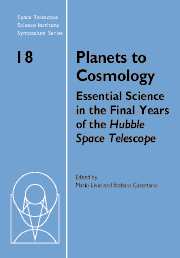 Planets to Cosmology
Planets to Cosmology Book contents
- Frontmatter
- Contents
- Participants
- Preface
- Hubble's view of transiting planets
- Unsolved problems in star formation
- Star formation in clusters
- HST abundance studies of low metallicity stars
- Physical conditions and feedback: HST studies of intense star-forming environments
- Quasar hosts: Growing up with monstrous middles
- Reverberation mapping of active galactic nuclei
- Feedback at high redshift
- The baryon content of the local intergalactic medium
- Hot baryons in supercluster filaments
- Galaxy assembly
- Probing the reionization history of the Universe
- Studying distant infrared-luminous galaxies with Spitzer and Hubble
- Galaxies at z ≈ 6–i′-drop selection and the GLARE Project
- The Hubble Ultra Deep Field with NICMOS
Galaxies at z ≈ 6–i′-drop selection and the GLARE Project
Published online by Cambridge University Press: 17 August 2009
- Frontmatter
- Contents
- Participants
- Preface
- Hubble's view of transiting planets
- Unsolved problems in star formation
- Star formation in clusters
- HST abundance studies of low metallicity stars
- Physical conditions and feedback: HST studies of intense star-forming environments
- Quasar hosts: Growing up with monstrous middles
- Reverberation mapping of active galactic nuclei
- Feedback at high redshift
- The baryon content of the local intergalactic medium
- Hot baryons in supercluster filaments
- Galaxy assembly
- Probing the reionization history of the Universe
- Studying distant infrared-luminous galaxies with Spitzer and Hubble
- Galaxies at z ≈ 6–i′-drop selection and the GLARE Project
- The Hubble Ultra Deep Field with NICMOS
Summary
Within the last few years, a number of public and legacy projects have generated very deep photometric datasets. The Hubble Space Telescope (HST) leads the way in this field, with the high spatial resolution and ability to detect very faint galaxies essential for this challenging work. The Advanced Camera for Surveys (ACS) on HST has now carried out several large deep surveys, including the Great Observatories Origins Deep Survey (GOODS) and the Hubble Ultra Deep Field (HUDF). These have been designed to allow the systematic broadband selection of very high redshift galaxies (z > 5) using the SDSS-i′ and z′ filters. This endeavor to identify faint and distant galaxies has been complemented by advances in spectroscopy. The current generation of spectrographs on 8m-class telescopes and the development of new techniques such as Nod & Shuffle have allowed the spectroscopic limit to be pushed to ever fainter magnitudes. The Gemini Lyman-Alpha at Reionization Era (GLARE) project is a spectroscopic campaign which aims to obtain 100-hour Gemini/GMOS spectra for a large number of z ≈ 6 galaxy candidates in and around the Ultra Deep Field. We describe the use of the i′-drop photometric technique to identify very high-redshift candidates in the data of the public GOODS and HUDF surveys. We comment on confirmed high-redshift galaxies discovered using this technique. We then discuss the photometric and spectroscopic characteristics of the galaxy sample resulting from the first 7.5 hours of GLARE observations.
- Type
- Chapter
- Information
- Planets to CosmologyEssential Science in the Final Years of the Hubble Space Telescope: Proceedings of the Space Telescope Science Institute Symposium, Held in Baltimore, Maryland May 3–6, 2004, pp. 185 - 194Publisher: Cambridge University PressPrint publication year: 2006


